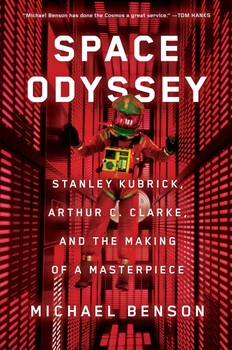 By MICHAEL BENSON (Simon & Schuster; 2018)
By MICHAEL BENSON (Simon & Schuster; 2018)
Appearing just in time for the fiftieth anniversary of Stanley Kubrick’s 2001: A SPACE ODYSSEY, this book can lay claim to being the definitive resource on the making of that classic. Certainly there already exist quite a few books on the subject (THE MAKING OF KUBRICK’S 2001, THE LOST WORLDS OF 2001, 2001: FILMING THE FUTURE), but SPACE ODYSSEY, in its erudition, readability and sheer breadth of information, easily outdoes them all.
…this book can lay claim to being the definitive resource …
2001: A SPACE ODYSSEY’s inception is covered here through a wealth of interviews, both new and archival, with Kubrick, screenwriter Arthur C. Clarke, special effects whiz Douglas Trumbull, actors Keir Dullea and Gary Lockwood, and virtually everyone else involved. It begins in early 1964, with Clarke receiving a letter from Kubrick about his desire to create a “‘really good’ science fiction movie,” setting off a labor-intensive four year saga that Michael Benson details step by arduous step.
2001: A SPACE ODYSSEY’s inception is covered here through a wealth of interviews, both new and archival…
Kubrick and Clarke eventually settled on Clarke’s story “The Sentinel” as the germ of their film. Its narrative was outlined in a novel written long before filming began, yet whose publication Kubrick held off throughout the production of the film, causing the cash-strapped Clarke great financial hardship. As for that production, it was a time-consuming, energy-draining ordeal that pushed everyone involved to the limits of their endurance, and resulted in a film that was initially reviled by critics, and took several decades to be properly recognized for the ground-breaking cinematic masterwork it was and remains.
All this info is, again, well documented in the previous 2001 books mentioned above. What Michael Benson adds is a wealth of esoteric detail that’s unique to this text. We learn here, for instance, that a sincere attempt at depicting an alien life form was made involving actor/choreographer Daniel Richter (who also played Moon-Watcher, the head ape-man of the opening scenes), an attempt that was ultimately discarded; that location scouting the desolate scenery of the opening scenes involved a death-defying desert trek, and the theft of several trees from a preserve in South Africa; and that the film was heavily inspired, unexpectedly enough, by Ingmar Bergman’s violent period piece THE VIRGIN SPRING, a film that like 2001 was marked by highly symmetrical compositions and extremely sparse dialogue. We also get a detailed description of 2001’s disastrous premiere screening, described by Benson as “one of the darkest nights of Stanley Kubrick’s life.”
Throughout, Benson can’t help but fawn over Kubrick’s brilliance and ambition, but he’s also quite frank about the great man’s more unpleasant predilections. Included in this category was the withholding of choreographer credit for Richter—because, apparently, Kubrick decreed that only he would have more than one credit on the film—and the crediting of himself as “Special Effect Designer,” which pissed off Douglas Trumbull mightily, and drove a wedge between him and Kubrick that lasted until well into the nineties (after which, Trumbull claims, he finally made peace with his mentor).
This is all contained in around 450 extremely well-ordered pages that answer virtually every question one might have about 2001: A SPACE ODYSSEY, while flummoxing those of us who thought we knew everything there was to know about the film. In short, it’s a must-read.
